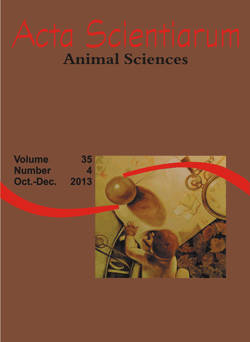<b>Glycerin levels in the diets for crossbred bulls finished in Feed-lot: ingestive behavior, Feeding and rumination Efficiency</b> doi:10.4025/actascianimsci.v35i4.19090
Keywords:
Comportamento, bovinos, consumo, confinamento, glicerol
Abstract
This work was carried out to study corn substituting by glycerin levels on animal behavior, feeding and rumination efficiency of Purunã young bulls finished in feed-lot. It was utilized 40 bulls Purunã breed with 208.8 ± 33.75 kg and 8 months old. The diets were: without glycerin - G00, 6% of glycerin – G06, 12% of glycerin – G12 and 18% of glycerin – G18. Dry matter intake was similar among diets. On the other hand, NDF intake decreased linearly with glycerin levels supplementation in the diets. FEDM and FENDF were similar among diets. REDM and RENDF were not changed due glycerin levels. Glycerin changed activities durations of bulls. Glycerin did not affect feed frequency. At contrary, rumination frequency was reduced linearly with glycerin inclusion. Others activities frequencies showed a quadratic effect with the glycerin addition. Glycerin inclusion in the diet reduced the time duration for feed frequency, but had no effect on the time spent for rumination frequency. However, the frequency duration for other activities increased linearly with glycerin inclusion.Downloads
Download data is not yet available.
Published
2013-05-27
How to Cite
Eiras, C. E., Marques, J. de A., Torrecilhas, J. A., Zawadzki, F., Moletta, J. L., & Prado, I. N. do. (2013). <b>Glycerin levels in the diets for crossbred bulls finished in Feed-lot: ingestive behavior, Feeding and rumination Efficiency</b> doi:10.4025/actascianimsci.v35i4.19090. Acta Scientiarum. Animal Sciences, 35(4), 411-416. https://doi.org/10.4025/actascianimsci.v35i4.19090
Issue
Section
Ruminant Nutrition
DECLARATION OF ORIGINALITY AND COPYRIGHTS
- I Declare that current article is original and has not been submitted for publication, in part or in whole, to any other national or international journal.
The copyrights belong exclusively to the authors. Published content is licensed under Creative Commons Attribution 4.0 (CC BY 4.0) guidelines, which allows sharing (copy and distribution of the material in any medium or format) and adaptation (remix, transform, and build upon the material) for any purpose, even commercially, under the terms of attribution.
Read this link for further information on how to use CC BY 4.0 properly.
0.9
2019CiteScore
29th percentile
Powered by 








































